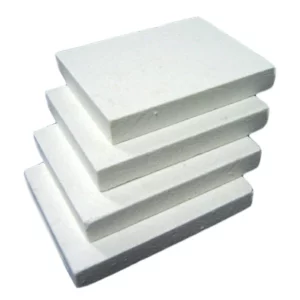Ceramic fiber insulation boards offer several advantages over traditional refractory materials when it comes to installation.
Here are some key points of comparison:
Lightweight: Ceramic fiber insulation boards are significantly lighter in weight compared to traditional refractory materials such as dense firebricks or castable refractories. This lightweight nature makes them easier to handle, transport, and install. It reduces the physical strain on workers during installation, especially when dealing with large or complex structures.
Ease of Cutting and Shaping: Ceramic fiber insulation boards are relatively easy to cut, shape, and fabricate. They can be easily trimmed or shaped using common hand tools like knives or saws. This allows for more flexibility in adapting the boards to fit complex shapes, curves, or irregular surfaces. In contrast, traditional refractory materials often require specialized cutting tools or skilled masonry work to achieve the desired shape.
Faster Installation: Due to their lightweight and ease of cutting, ceramic fiber insulation boards can be installed more quickly compared to traditional refractory materials. They can be easily positioned, secured, and attached using various mechanical fixing methods such as adhesives, screws, or metal anchors. This saves time during installation and reduces labor costs.
Reduced Thermal Mass: Ceramic fiber insulation boards have lower thermal mass compared to dense refractory materials. This means they heat up and cool down faster, resulting in shorter heat-up and cooldown times during installation and operation. It allows for quicker temperature stabilization and reduces energy consumption.
Thermal Insulation Performance: Ceramic fiber insulation boards offer excellent thermal insulation properties, which can be comparable or even superior to traditional refractory materials. They provide effective heat containment, reducing heat loss and improving energy efficiency. This is particularly beneficial in applications where minimizing heat transfer is crucial.
Expansion and Contraction: Ceramic fiber insulation boards have better resistance to thermal expansion and contraction compared to some traditional refractory materials. They can accommodate thermal cycling and temperature variations without suffering from cracking or spalling, ensuring long-term stability and durability.
It’s important to note that while ceramic fiber insulation boards offer advantages in terms of installation, they may have limitations depending on the specific application and operating conditions. Factors such as maximum temperature, chemical exposure, mechanical stress, and structural requirements should be carefully considered when selecting insulation materials. Consulting with experts or manufacturers can help determine the most suitable insulation solution for your specific needs.
What are some common applications where ceramic fiber insulation boards are used?
Ceramic fiber insulation boards find applications in various industries and environments where high-temperature insulation and thermal management are required.
Some common applications include:
Furnace and Kiln Linings: Ceramic fiber insulation boards are widely used for lining the walls, roofs, and doors of industrial furnaces, kilns, and ovens. They provide thermal insulation, reducing heat loss and improving energy efficiency. The boards help maintain uniform temperature distribution, enhance heat containment, and protect the structural integrity of the equipment.
Thermal Insulation in Power Generation: Ceramic fiber insulation boards are employed in power plants, boilers, and thermal power equipment for insulation purposes. They insulate walls, ducts, and other high-temperature components, helping to conserve heat, improve energy efficiency, and enhance overall performance.
Petrochemical and Refining Industries: In the petrochemical and refining industries, ceramic fiber insulation boards are used to insulate pipes, ceramic fiber insulation board vessels, reactors, and other equipment that handle high-temperature fluids or gases. The boards provide thermal insulation, ensuring efficient heat management, and reducing energy loss.
Heat Shields and Fire Protection: Ceramic fiber insulation boards are utilized as heat shields and fire protection barriers in various applications. They are used in automotive, aerospace, and marine industries to protect sensitive components from high temperatures and provide passive fire protection.
Foundries and Metal Processing: Ceramic fiber insulation boards are used in foundries and metal processing facilities for lining and insulating furnaces, crucibles, ladles, and other equipment involved in metal melting, casting, and heat treatment processes. They help maintain desired temperatures, improve energy efficiency, and protect against heat loss.
High-Temperature Insulation in Appliances: Ceramic fiber insulation boards are employed in appliances such as ovens, stoves, and kilns used in residential, commercial, and industrial settings. The boards provide thermal insulation, contributing to efficient heat distribution and energy savings.
Thermal Insulation in HVAC Systems: Ceramic fiber insulation boards are used in heating, ventilation, and air conditioning (HVAC) systems to insulate ductwork, boilers, and other high-temperature components. They help minimize heat loss, improve system efficiency, and enhance thermal comfort.
Insulation in Aerospace and Defense: Ceramic fiber insulation boards are utilized in the aerospace and defense industries for insulation in aircraft engines, rocket engines, exhaust systems, and other high-temperature applications. They provide thermal insulation, protect against heat transfer, and enhance overall performance.
These are just a few examples of the applications where ceramic fiber insulation boards are commonly used. The specific application and operating conditions will determine the required thickness, density, temperature rating, and other properties of the boards. It’s important to consult with experts or manufacturers to select the appropriate ceramic fiber insulation boards for your specific needs.



